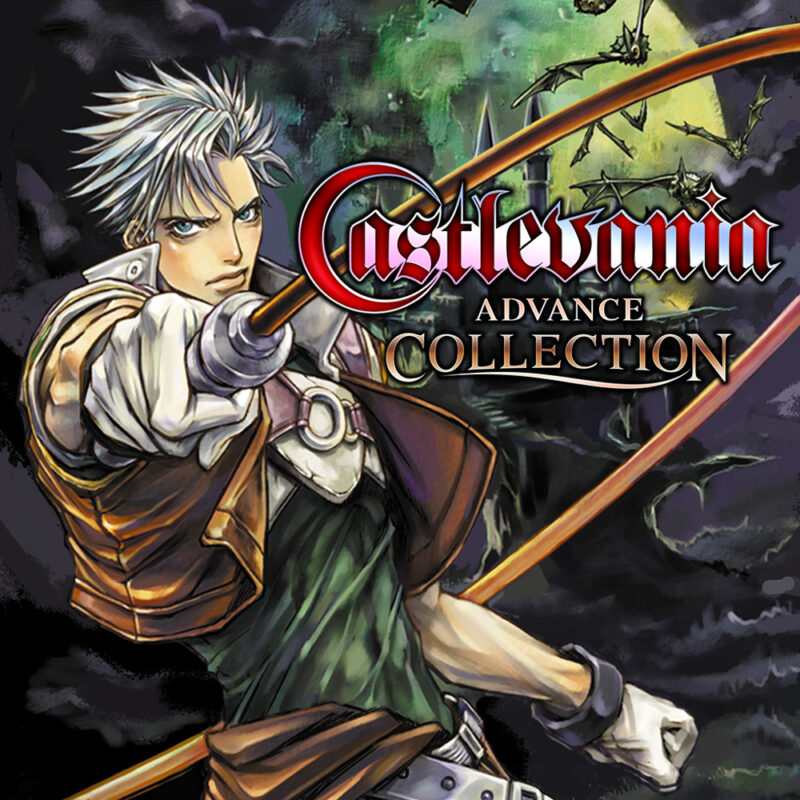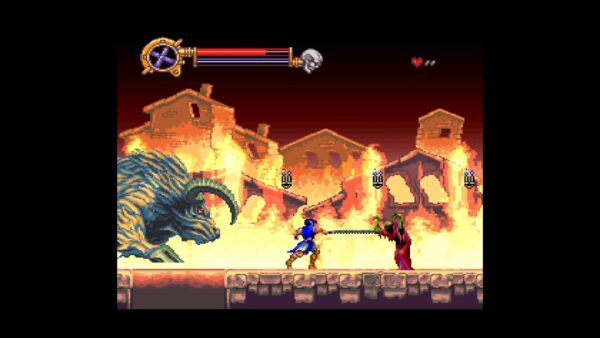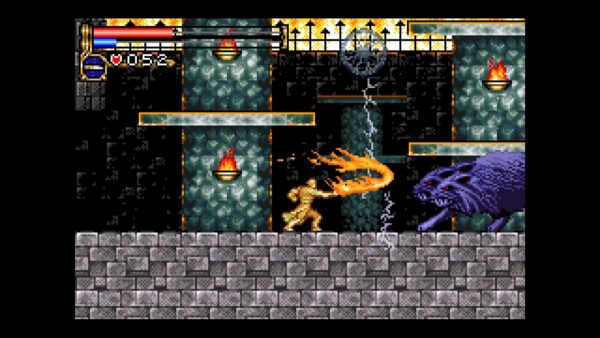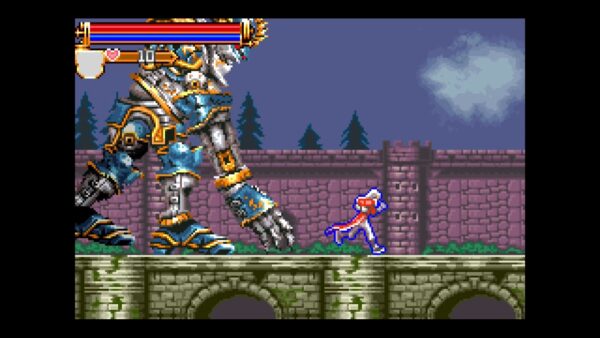
In 2019, Konami released the Castlevania Anniversary Collection, which contained eight classic games in the series lineup, much to fans’ joy. But there were more games fans wanted and Konami obliged with the Castlevania Advance Collection, containing the three Game Boy Advance games, and surprisingly the SNES version of Dracula X. But there is more to this collection that meets the eye.
Konami and M2 did not just repeat the emulation style of the first collection here, but instead made a number of improvements. The games now have an HQ Audio option that is set to default and helps improve the music in the games, while there are also a number of screen filter and size options. The Advance Collection also has a number of save options, including multiple save states, and files, but also contains a handy rewind feature in all of the games.
Castlevania Dracula X is often thought of as an inferior port of Rondo of Blood to the Super NES but it can be more accurately called an adaptation as a large number of changes were made. The difficulty is noticeable, especially with the stiff control, and story elements were drastically changed from the PC Engine original, along with the removal of all cutscenes. What we were left with was a game that plays much like Castlevania III on NES but with the skin of Rondo of Blood.

It is not all bad though, as while the music could not match the CD audio, some of the songs such as Bloodlines did get a chance to shine, and the HQ Audio helps it pop out here. Some of the stages took advantage of the SNES’s visual capabilities over the PC Engine to have some better effects. The intense difficulty of the game is also lessened here because of the rewind feature, and while many have debates about using such a feature, it was brought in by Konami to be used and therefore is fine to use.
What we have is an inferior adaptation of a classic that is still interesting to see. The game has different stages, and while Maria is no longer an unlockable character, she does appear in a slightly different role this time. If the rewind feature is used liberally and time is taken to explore what Dracula X has to offer, the game does have some value.
Rondo may be the best of the Classicvania’s but its little cousin on the SNES has some elements that make it worth checking out, such as the rearranged stages, different bosses and more. This is best viewed as a bonus game to the three GBA titles and as an appetizer to the main course. When viewed in this way, the game manages to add some value to the collection.
Castlevania Circle of the Moon was the first of the GBA Castlevania trilogy and the first Metroidvania title since the release of Symphony of the Night. IGA was not involved in this game and later declared it to be non-canonical. This fact is often used to criticize the game as a lesser title, but this is a weak argument.
Circle of the Moon may not have fit IGA’s vision for the series, but there were many great things about the title. The music in the game is of extremely high quality, and the HQ Audio option in the collection makes it pop even more. There is even some music lifted from Symphony of the Night when the game is started, which helps emphasize how much this GBA title was modelled after the PlayStation game.

Circle of the Moon introduced the DSS system, where enemies would drop two different styles of cards that the protagonist Nathan Graves could equip for new abilities. Some of these abilities were useful for the game and some were not, but it was an interesting concept and no doubt helped influence the Tactical Soul System in Aria of Sorrow. The sub-weapons will still be used more, but the card system was an important step for Castlevania.
Circle of the Moon controls mostly well, but there is a bit of stiffness when Nathan is moving. It is not too significant of a problem to deal with, but it is something to keep in mind when playing. Nathan only uses the whip but can use the cards to give it some new abilities here and there, and it is fun to experiment.
One of the biggest complaints about the game was that the visuals were too dark on the non-backlit original GBA, but that is no longer an issue for this release. The visuals are a bit basic compared to what came afterwards on the GBA but are definitely serviceable enough. The various screen quality presentations will also help out here. The end result is that Circle of the Moon shines bright as a great entry in this collection and holds up mostly well.
Harmony of Dissonance was IGA’s return to the series and his influence shows. Juste Belmont, the grandson of the legendary Simon, feels very much like Alucard did, albeit as a whip wielder. The visuals were brighter here, and the controls were far less stiff, but one area where the game fell short was the music.
Simply put, Harmony of Dissonance has a less than stellar soundtrack, and some sections are unpleasant to listen to. It is not all bad, and some of the problems with the soundtrack have been exaggerated over the years, but when the music is bad, it is very bad. For the most part, though, the soundtrack is simply below average for what the Castlevania series usually has to offer.

In terms of gameplay, Harmony of Dissonance is among the best in the series, as Juste has many great abilities to help him out on his journey. Players can equip multiple items to gain new abilities, such as the ability to spin the whip much like Nathan Graves in Circle of the Moon. Juste will find spell books throughout the castle, and these can be equipped to use more powerful abilities similar to the item crash in Rondo of Blood at a similar cost.
What makes Harmony of Dissonance stand out is the dual castle system that greatly changed up the experience and allowed for more exploration. This felt like a natural extension of the inverted castle from Symphony of the Night and actually felt more integrated into the experience. Add in the collectibles and the story twists, and Harmony of Dissonance still holds up well today, with the weak point being the music. If the music can be looked past, especially thanks to enhancements from the HQ Audio, then Harmony of Dissonance should rate higher than Circle of the Moon.
The final GBA Castlevania was Aria of Sorrow, which feels like the combination of the best of the two games that came before. Set in the future instead of the past, the game sees Soma Cruz and his childhood friend Mina Hakuba finding themselves in Dracula’s castle after going to witness a solar eclipse. Soma discovers he has the ability to absorb enemy souls and use their powers and soon must make his way to the throne room.
Graphically, this is the best looking of the trilogy and it is also the best sounding, as the music is original while Circle of the Moon reused older music, and the sounds are amazing here. The GBA audio fuzziness gamers are used to, is not noticeable in this collection thanks to the HQ Audio, and the game looks amazing on a big screen TV as well. Aria of Sorrow also controls far better than the previous entries, lacking the stiffness of Circle of the Moon or the looseness of Harmony of Dissonance.
Aria of Sorrow’s biggest attraction is the Tactical Soul System, where Soma can absorb three kinds of souls and use them for attacks, abilities or stats. New to this collection is a counter that keeps track of which souls the players have obtained from specific enemies, and this is also present in Circle of the Moon as well for the DSS system. If this proves distracting, however, players can disable it and simply play without it.

The Tactical Soul System is a brilliant addition to the series and definitely made Aria of Sorrow stand out, but at some points does feel like it could have been fleshed out more. There is no need to obtain multiples of a soul for instance, and this is something that was addressed in the sequel Dawn of Sorrow. That being said, Soma’s various abilities are fun to use, and part of the game’s appeal is collecting all of them, especially for the best ending.
No spoilers will be given here, but the secret to getting the true ending is also a bit obtuse and could have been explained far better. All that said though, the actual ending is one of the best moments in the series and opened the door for new possibilities. Dawn of Sorrow capitalized on some of these opportunities but that is a story for another time.
What can be said now though, is that Aria of Sorrow has a lot of replay value. Beating the game with the true ending will unlock Hard Mode, which has new items to obtain, as well as Julius Mode. This mode sees you play as the whip wielder and show how powerful he truly is.
In terms of how well the games actually hold up, Dracula X is an interesting one. The enhanced audio, rewind features and other QOL improvements actually make it a better experience than when it was first released on the SNES, due to how much of a difference they make in the experience. With regards to the GBA games, Aria holds up the best and is just as playable now as it was then, while Harmony of Dissonance and Circle of the moon take a bit of adjusting due to the controls. Both are very much playable, however, and as stated above, when the audio of Harmony is looked past, it plays great.

Also included in the collection is a gallery mode that shows off art from the four games, and it is beautiful to look through. The art designs and concepts from the series are always fascinating to see, but the music player is also a must-visit addition. The music player lets gamers experience each song at their leisure, and even the one or two good songs in Harmony of Dissonance can be singled out for enjoyment. It helps that the HQ Audio makes the music sound so much better, and there is even the option of making a customized playlist of the music.
While there are only four games here compared to the eight of the anniversary collection, Castlevania Advance Collection goes for quality over quantity, and no one can doubt the greatness of the GBA trilogy. M2 added excellent Quality of Life changes as mentioned above, display options, including CRT features for Dracula X, and a synopsis for each game at the selection screen.
Due to the diversity of the titles and the amazing features, Castlevania Advance Collection is a must-play on any system. Konami and M2 did a great job here and both preserved and enhanced the classics. This is a highly recommended collection to check out.
Disclaimer A review key was provided
Images were taken from Nintendo.co.uk

